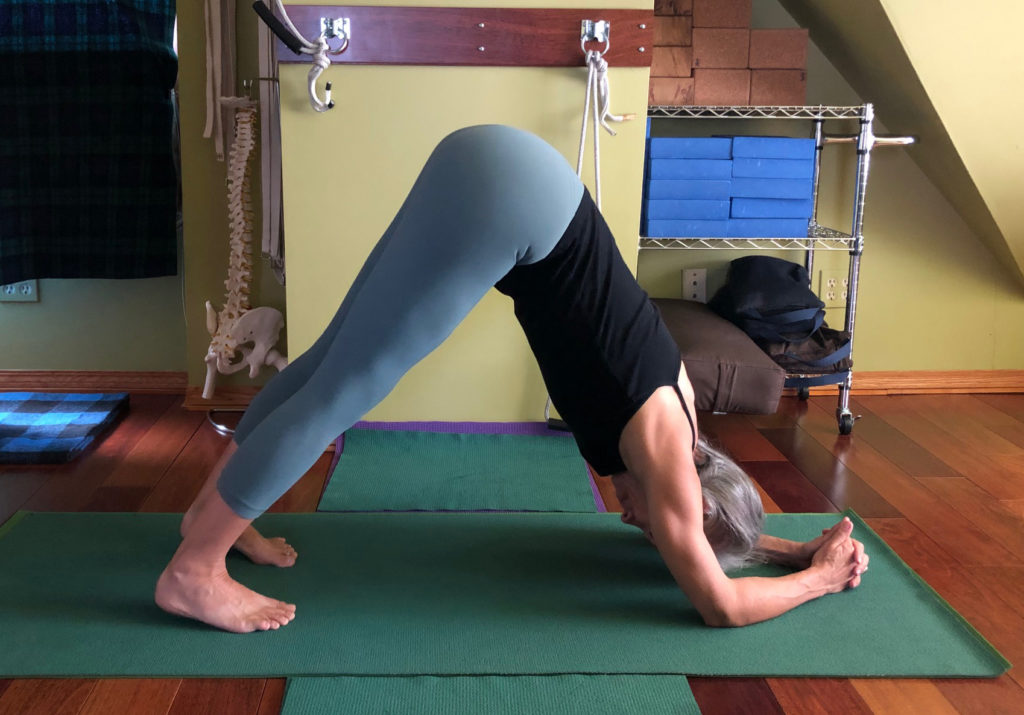Sirsasana or Headstand is referenced as the King of Asanas because of its many benefits. Turning ourselves upside down promotes both physiological and psychological health.
Benefits of Sirsasana:
- Strengthens neck, shoulder, abdomen, and spinal muscles
- Induces relaxation, particularly in the face
- Eases headaches
- Calms and deepens the breath, which increases brain functioning
- Activates vigor and alertness while reducing stress
- Reduces acne and facial wrinkles
- Treats vertigo
- Reduces varicose veins
- Contributes to kidney, liver, stomach, and intestinal health
- Adds to reproductive health, particularly relieving infertility
- Improves eyesight
However, Sirsasana, whether headless or in its full expression with the crown on the floor, is not a pose for practitioners without a solid standing pose practice. Because of the additional weight on the shoulders, cervical spine, and skull, the yogi’s lumbar, sacrum, tailbone, and legs must actively lift toward the ceiling. When practitioners cannot lift the torso’s weight off the cervical spine and neck muscles, the compression results in pinched nerves and damaged vertebrae.
A safe way to prepare for Sirsasana is with Sirsasana Adho Mukha Svanasana as illustrated below. Hold this pose with your head off the floor for 1 to 3 minutes. Build to the longer hold as your strength increases.

Once the Downward Dog variation of Sirsasana feels comfortable, progress to Headless Sirsasana below. Remember, the crown never touches the floor whether in the kick-up to the wall or once the heels are resting at the wall.

It is suggested that when you can hold Headless Sirsasana for two minutes, you are strong enough to take the full pose with the centre of the crown on the floor. Keep your heels on the wall until you can balance without support. Keeping the heels at the wall eases weight-bearing on the cervical spine. Once balance is no longer an issue, move away from the wall as illustrated below. Notice how my legs are actively engaged in lifting weight off my spine, arms, and neck.

Many yoga studios are restricting the practice of Sirsasana to headless variations, which encourages me to suggest that if you do the full posture do not hold it longer than two minutes.
Regardless of which Sirsasana variation you decide to practice, utilize the three Yoga Actions below to deepen your experience of the poses and yourself. If you prefer audio instruction, click on the file below.
Yoga Action (Annamaya Kosha):
– Lengthen down the outer, middle, and inner calf muscles into your heels.
Yoga Action (Pranamaya Kosha):
1) INHALE into your sternal notch, down the inner face of your breast bone to the Xyphoid Process. Feel the entire Thoracic cavity fill with air; front, back, and side-to-side.
2) EXHALE down the inner faces of the lumbar spine, sacrum, and tailbone into your legs.
Yoga Action (Manomaya Kosha):
– rest in the pose by silently repeating to yourself “I am peaceful and at ease.”
NOTE: It may take more than one pose before you awaken these yoga actions or areas in your body and begin to feel the arising sensations and releases. In that case, apply the three yoga actions to the following poses before trying Sirsasana –
GOMUKHASANA
ADHO MUKHA SVANASANA
PINCHA WALL STRETCH
PRASARITA PADOTTANASANA
For more yoga actions and teachings, click here. Namaste.





